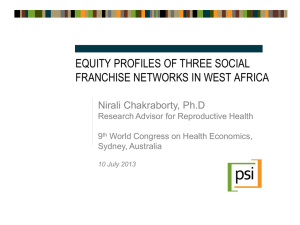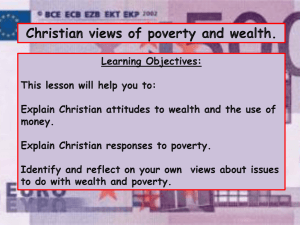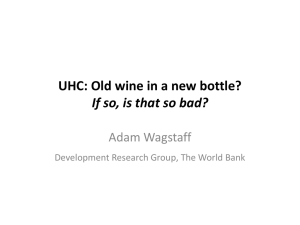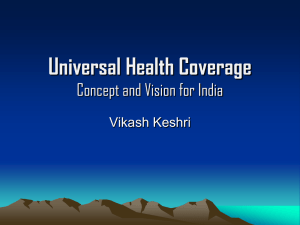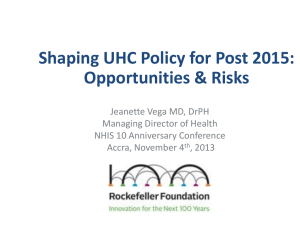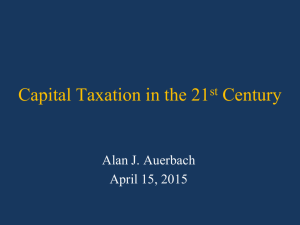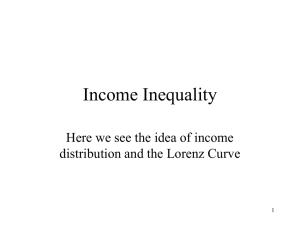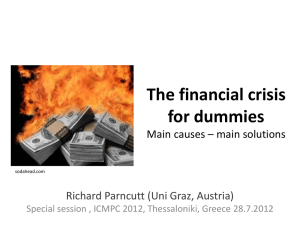Moderated Session Developing Measurement Matrices
advertisement
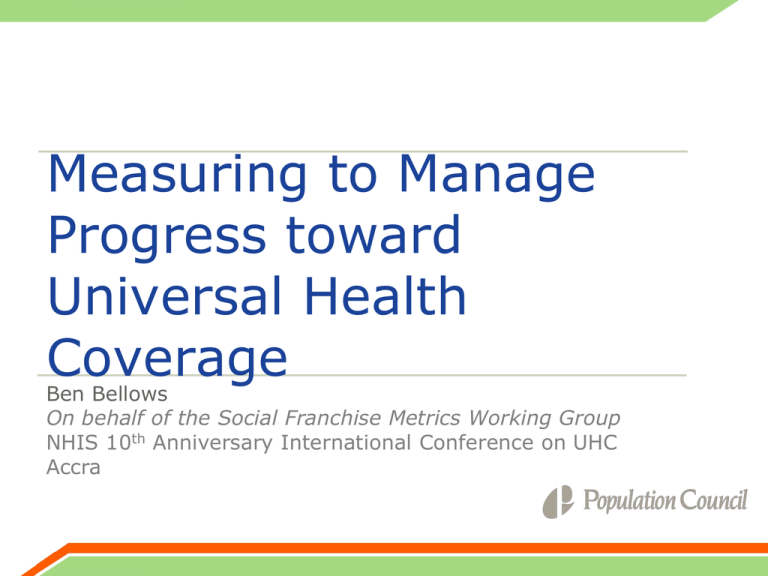
Measuring to Manage Progress toward Universal Health Coverage Ben Bellows On behalf of the Social Franchise Metrics Working Group NHIS 10th Anniversary International Conference on UHC Accra UHC is multidimensional & aspirational Access: Expand coverage to wider How universal can vouchers really be? population Despite growing evidence for vouchers’ impressive impact in terms of equity, Scope: Improve financial protection and quality of care, they remain for now aquantity specific tool to of enable quality & underserved groups to access priority services. However the WHO’s ‘cube’ frames health services offered progress towards UHC in terms of the share of people, servicesprotection: and costs covered, with Financial a focus on growing these three dimensions Improve size as far as possible of . Given this understanding of UHC, how important can subsidies or to UHC reduce vouchers’ contribution really be? informal charges The first point to remember is that vouchers xi do not have to be targeted. For example, all families were eligible for the wildly successful family planning voucher programmes in Korea and Taiwan in the 60s-90s. Even among targeted voucher programmes, some Figure 1: WHO's Universal Health Coverage 'Cube' Pitfall 1: Social Health Insurance can emphasise curative care at the expense of public health and preventative care Access is far from universal in 54 LMIC • Of 12 MNH interventions in a review of public data across 54 countries, family planning was the third most inequitable *Barros, A. J. D., Ronsmans, C., et al. (2012). “Equity in maternal, newborn, and child health interventions in Countdown to 2015: a retrospective review of survey data from 54 countries”. Lancet, 379(9822), 1225-33. Limited financial protection is common in 51 LMIC* • • • • 13–32% of household expenditures over 4 weeks went to healthcare 25% poor households incurred potentially catastrophic healthcare expenses >40% of households used savings, borrowed money, or sold assets to pay for care 41-56% of households spent 100% of health care expenditures on medicines *Wagner, Graves, Reiss, LeCates, Zhang, Ross-Degnan. 2011. “Access to care and medicines, burden of health care expenditures, and risk protection: Results from the World Health Survey” Health Policy. 100(2-3):151-158 Selected constructs and metrics for UHC measurement Quality of care: • Donabedian framework (structure, process, outcomes) • Investment in facility infrastructure Financial protection: • Out-of-pocket spending on health paid for by the patient at the point of service • Proportion of household consumption that is spent on healthcare Equitable access: • Geographic proximity • Above or below a poverty line • Member of a wealth quintile Preferred characteristics in a UHC equity measure • Program Managers • Quick, inexpensive to collect • Easy to interpret by managers and field staff • Agency Headquarters • Standardized & comparable nationally • Easy to explain to policy makers • Other Stakeholders • Comparable internationally • Clients • Transparent, trustworthy, quick application process • Time-delimited membership • Recognition of solidarity • Recourse for appeal Pilot study: Find a good routine, monitoring equity indicator Progress out of Poverty Index (PPI) • Wealth Index (WI) Multidimensional Poverty Index (MPI) MPI dismissed: not feasible to collect • PPI and Wealth Index piloted in 5 countries in 2012 as part of franchise client exit interviews • Results compared against selection criteria PPI tools DHS questions Results & indicator attributes Wealth Index PPI Relative measure Uses DHS data to compare client sample to national wealth quintiles Low-cost because DHS data is publicly available Absolute measure Asset list gives likelihood that a client is under $1.25/day poverty threshold Expensive: unique asset weights developed for each country Quintile India Madag Benin DRC Mali n=797 n=853 n=535 n=242 n=293 1 (Poorest) 27.9 2.1 3.4 0 0 2 (Poorer) 22.5 9.3 2.4 0 0 3 (Middle) 21.7 25.4 4.3 0 0.3 4 (Richer) 15.3 38.6 13.1 9.1 13.9 5 (Richest) 12.7 24.6 76.8 90.9 85.7 Only 6% of Benin franchise clients are from the bottom 40% of the population Threshold Clients Benin Pakistan Philippines Vietnam $1.25/da y Franchise 19% 17% 17% 8% National 47% 21% 18% 17% Franchise 61% 72% 51% 51% National 75% 60% 42% 43% $2.50/da y 19% of Benin franchise clients living under the $1.25/day threshold vs. 47% of the national population Selection criteria Criteria PPI Wealth Index Easy to Collect and Interpret Easy to collect Easy to collect Easy to calculate Difficult to calculate Easy to interpret poverty threshold Quintiles widely used/understood $20,000-$25,000 per country Inexpensive Requires some upkeep costs Based on publicly-available DHS Percent of clients under poverty line easily Wealth quintiles accurate and validated Low Cost Comparable to National Context comparable to national poverty rate Difficult/impossible subgroup analysis e.g.: comparison to national distribution Easy subgroup analysis just urban, or just FP clients Comparable Across Countries Percentage of clients under $1.25/day standard across countries Can discuss percentage of clients that fall within bottom 40%, but measure is relative to a country Using Wealth Index routinely • • • • • Randomly select NHIS facilities or enrollment centers Conduct exit surveys among clients • 20 questions about household characteristics • Adds approximately 10 minutes to each interview Centralized data analysis in M&E unit – takes about 8 hours Build capacity through a tool kit and standard syntax files Conduct surveys on quarterly or semi-annual basis Uganda & Kenya: Equity targeting for program enrollment • Uganda & Kenya voucher programs • Every client identified in the community using a short targeting tool • Voucher expires after a year and can only be used for one service package. Respondents who had ever used the HealthyBaby voucher in Uganda (20102011) 35% 30% 25% 20% 15% 10% 5% 0% Poorest quintile Poorer quintile Middle quintile Richer quintile Richest quintile Does NHIS enrollment vary by wealth quintile? 50% 40% Women (DHS 2008) All (SHINE, 2009) 30% 20% 10% 0% Poorest Less poor Middle Less rich Richest Conclusions: Active equity targeting is key component of UHC • • • • Tools exist that can cost-effectively identify the poor for enrollment who, in the absence of the active identification, would not have become NHI members Monitor samples of clients for reporting against performance targets Use for beneficiary identification and enrollment Consider: Are other exemptions as effective to achieve the same objective? Thank you Social Franchising Metrics Working Group • • • • • • • • • • • Bill & Melinda Gates Foundation DKT International Planned Parenthood Federation Johns Hopkins Marie Stopes International Population Services International Rockefeller Foundation Population Council University of California San Francisco USAID World Health Partners
